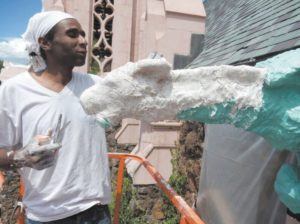 Like emergency first responders, community members are answering the call for help and asking for backup as they work to save severely deteriorating features of the historic Nativity of Blessed Virgin Mary Chapel.
Like emergency first responders, community members are answering the call for help and asking for backup as they work to save severely deteriorating features of the historic Nativity of Blessed Virgin Mary Chapel.
Unique features, including the bell tower cladding, fierce gargoyles and casings that support hand-crafted stained glass windows, are visibly decaying. After enlisting professional investigative engineers to study the extensive erosion problem in 2016, a group of parishioners learned that volcanic chemicals in the decorative concrete are primarily responsible for the decay through a process called Alkali Silica Reaction (ASR).
“Unfortunately, some of the aggregate that they used when they mixed the concrete was volcanic. Two types of volcanic aggregate are causing the problem: rhyolite and dacite. Little particles of those two types of rock have silica in them. The silica reacts with the alkali in the cement and forms a white gel that expands when exposed to water. It has nowhere to go, so it cracks the concrete,” said civil engineer Carolyn Searls, a senior principal at Simpson, Gumpertz and Heger (SGH), a San Francisco-based engineering firm with expertise in historic masonry restoration and preservation that diagnosed the problem.
Prior to SGH completing its engineering report on the structure in November 2016, some mitigation work had been done, including casts made of the most intact gargoyles, removal of loose debris and the application of elastomeric paint to raw concrete on the tower as an interim step to prevent water from seeping into areas of greatest decay. Since then, Civil Design & Engineering (CD&E), a local engineering firm, has completed a LIDAR laser scan of the exterior of the building pro bono. The data from the scan will be used to generate elevations and restoration construction drawings.
Long-time Flagstaff residents including Dr. Rayma Babbitt Sharber, Patsy McCullough, Patrick Nackard, Mike Loven and the Babbitt Brothers Foundation have supported the effort. A $10,000 grant from the City of Flagstaff Heritage Preservation Commission has also helped with treatment expenses. Although a projected budget for the entire restoration project is still pending, estimates run in the range of $2.5 million.
“This is a massive undertaking,” said Roberta (Birdie) Wallace, who is leading the project. “Inasmuch as the seriousness of the decorative concrete decay is a consequence of chemistry – not simply a product of weather, age or neglect – we face a very complex and comprehensive restoration challenge.”
The project includes restoring or replacing the tower cladding, buttress pinnacles, stained glass windows and protective shields, gargoyle downspout, and other decorative features. The roof is in disrepair as well, and there is extensive water damage inside the building.
The chapel was built in 1929 on land donated by David Babbitt. A Catholic priest, the Reverend Father Edward Albouy, modeled it after a church near his home in Rodez, France. “Along with the Flagstaff Federated Community Church on Aspen and the Episcopal Church of the Epiphany on North Beaver, those were the early significant church buildings in Flagstaff,” said historian Jim Babbitt. “Flagstaff, from early on, had a sizable Catholic community, including the Babbitts and the Riordan lumber family. Many community members have been baptized or married there. And, it’s a truly wonderful piece of ecclesiastical architecture.”
Nackard’s grandfather, a Lebanese immigrant and early Flagstaff business owner, helped fund the original construction of the church. “It’s unique, it’s gothic, it’s just a beautiful architectural place with gargoyles. Countless people stand there and take pictures with their friends on the steps. It’s a landmark in Flagstaff and we’ve got to get it back,” said The Nackard Companies owner.
For more information, visit the Nativity Restoration Project at savenativitybvm.com. Donations may be made on-line or mailed directly to Babbitt Brothers Foundation, Nativity Restoration Fund, P. O. Box 520, Flagstaff, AZ 86002. FBN
By Bonnie Stevens, FBN
Courtesy photo







